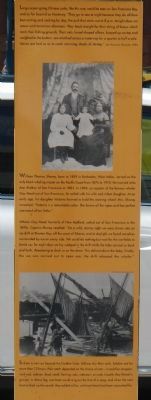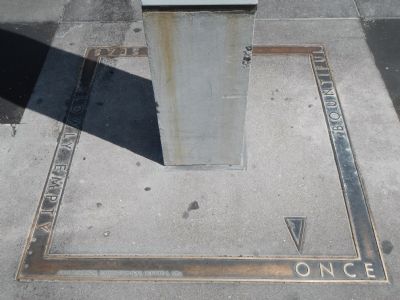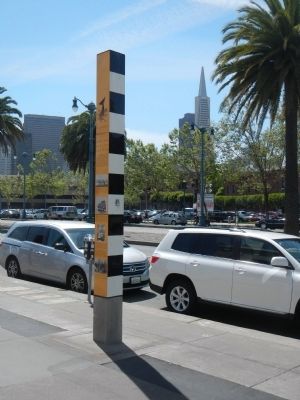Northern Waterfront in San Francisco City and County, California — The American West (Pacific Coastal)
Those Who Harvest the Sea
You are standing on the site of historic old Fisherman’s Wharf, from the early 1870s until Christmas 1900, the Italian fishing fleet moored their boats, called fellucas, at the foot of Telegraph Hill. Here was room to spread and mend nets, unload and sort fish, and pack them to sell. Chinese shrimp fishermen sailed out of Marin, South San Francisco, and Hunters Point. The Alaska Packers’ salmon fleet wintered over in Oakland, sailing north to fish each spring. From 1876 to 1929, San Francisco was the central whaling port for North America – as square-rigged and steam-powered whalers roamed the Arctic and far reaches of the Pacific.
Illustration 1
Marine Artist Gorgon Grant sailed on the last of the square-rigged ships, to draw life at sea in the 1920s and 30s.
Illustration 2
Artist Louis Choris traveled with the 1816 Russian expedition to San Francisco Bay and drew these Native-Americans plying their distinctive boats made of hollow tule reeds. For people who lived lightly on the land, the tule boat had many ideal qualities: one person could carry it easily; tule reeds could be found on any brackish stream so that boats could be quickly repaired; its shallow draft carried travelers far inland; sitting close to the water made it easy to sieve abundant quantities of fish into woven baskets.
Photograph 3
Large ocean-going Chinese junks, like this one, could be seen on San Francisco Bay, and as far beyond as Monterey. “They go to sea at night because they do all their best sorting and cooking by day; the junk that starts out at 8 p.m. tonight does not return until tomorrow afternoon. They head straight for their string of buoys which mark their fishing grounds. Their nets, funnel-shaped affairs, buoyed up on top and weighted to the bottom, are stretched across a waterway for a quarter to half-a-mile. Seines are laid so as to catch return shoals of shrimp.” - San Francisco Chronicle, 1893
Photograph 4
William Thomas Shorey, born in 1859 in Barbados, West Indies, served as the only black whaling master on the Pacific Coast from 1876 to 1910. He married Julia Ann Shelton of San Francisco in 1883. In 1894, as captain of the famous whaler Gay Head out of San Francisco, he sailed with is wife and infant daughter. At an early age, his daughter Victoria learned to hold the steering wheel. Mrs. Shorey remarked, “Victoria is a remarkable sailor, She knows all the ropes and has perfect command of her father.”
Whaler Gay Head, formerly of New Bedford, sailed out of San Francisco in the 1890s. Captain Shorey recalled: “On a wild, stormy night we were driven into an ice-drift at Shanter Bay, off the coast of Siberia, and at daylight we found ourselves surrounded by ice on every side. We could do nothing but wait for the ice-field to break up; for eight days we lay wedged in the drift while the tides carried us back and forth, threatening to dash us on the shore. This did not alarm the baby. Finally, the ice was carried out to open sea, the drift released the whaler.”
Photograph 5
In from a wet run beyond the Golden Gate, fellucas dry their sails. Seldom out for more than 12 house, their catch depended on the choice of nets – it could be sturgeon, rock cod, salmon, shad, smelt, herring, sole, calamari, or crab. Usually they fished in groups: in dense fog, one boat would sing out the line of a song; and when the next boat picked up the sound, the added a line, until each boat has been accounted for.
Embedded around the base
Once bountiful, the seas slowly empty... Anne Swardson, Washington Post, October 3, 1994
Erected by San Francisco Art Commission for the Waterfront Transportation Projects.
Topics. This historical marker is listed in these topic lists: Industry & Commerce • Waterways & Vessels. A significant historical date for this entry is October 3, 1994.
Location. 37° 48.132′ N, 122° 24′ W. Marker is in San Francisco, California, in San Francisco City and County. It is in Northern Waterfront. Marker is on The Embarcadero, on the right when traveling north. Touch for map. Marker is at or near this postal address: 780 The Embarcadero, San Francisco CA 94111, United States of America. Touch for directions.
Other nearby markers. At least 8 other markers are within walking distance of this marker. Buried Ships (within shouting distance of this marker); White Angel (about 500 feet away, measured in a direct line); Egg War of the Farallones (about 500 feet away); Gold Mountain (about 600 feet away); Green Street (about 600 feet away); Telegraph Hill (approx. 0.2 miles away); Building the Seawall (approx. 0.2 miles away); Vallejo Street (approx. 0.2 miles away). Touch for a list and map of all markers in San Francisco.
More about this marker. This marker is located in front of Pier 19.
Credits. This page was last revised on February 7, 2023. It was originally submitted on May 1, 2014, by Barry Swackhamer of Brentwood, California. This page has been viewed 563 times since then and 19 times this year. Photos: 1, 2, 3, 4, 5. submitted on May 1, 2014, by Barry Swackhamer of Brentwood, California. • Bill Pfingsten was the editor who published this page.




